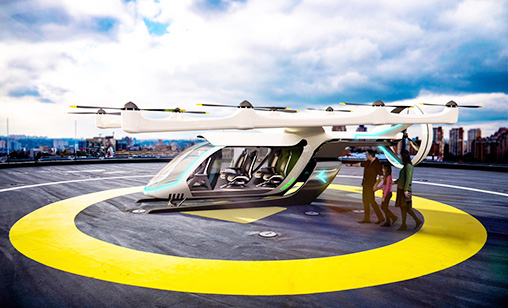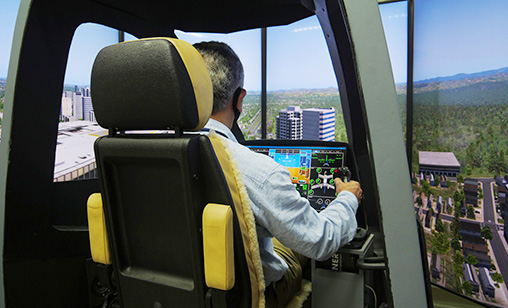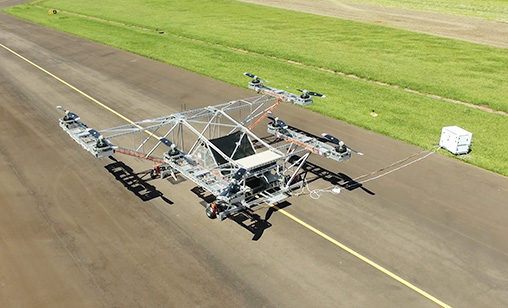News Backgrounder
Partnerships critical for Embraer’s Eve Air Mobility expansion in Asia-Pacific
October 1st 2021
Eve Air Mobility (Eve) vice president of business development, David Rottblatt, says there is great potential for urban air mobility in the Asia-Pacific as travellers seek to retrieve time lost from traffic congestion in cities across the region. Read More »
 |
Air taxi markets exist in many cities, but their usage is not widespread because of the usually high costs and limited networks that support the emerging sector.
The urban air mobility market is seeking to change that. At Eve, a developer of electric Vertical Take-off and Landing (eVTOL) aircraft, an air traffic management system is being designed for an urban environment and to answer the question of how to retrofit existing infrastructure for this form of transport.
Rottblatt said there is a lot of variation among Asia-Pacific countries in terms of preparedness for such transport systems. He nominates Bangkok, Manila and Tokyo, to name just three, as “ripe for this type of technology”.
“The Asia-Pacific is one of, if not the engine, of this entire global economy specifically because of the human geography in many countries in Asia-Pacific and the type of congestion that already exists in many cities,” Rottblatt told Orient Aviation in an interview from Boston.
“There is that shared pain point of traffic. There is that shared pain point of time lost.
“The Asia-Pacific is somewhat of an anomaly with respect to the rest of the world because of the heightened demand we expect some countries will have. Japan is an example. We think there will be as many as 200 to 300 eVTOLs needed to satisfy that demand in every major city.”
Then there is Singapore, which is developing the urban air mobility sector without the history of an air taxi market.
“Singapore is leapfrogging the conventional industry of the air taxi market and going straight to eVTOL technology,” Rottblatt said.
“It is very exciting that in spite of the fact it is relatively unfamiliar with the industry, it has become one of the world’s earliest adopters of the technology by supporting our peers in this space and preparing for commercial operations in 2024.
 |
“Quick, disruptive changes tend to be uncomfortable for a lot of communities, but Singapore has clearly demonstrated its ability to evolve very quickly.”
Rottblatt also cited Melbourne in Australia, a city with a vibrant existing air taxi market, as one to watch for market growth.
“We are very happy to be partnering with Airservices in the Melbourne market where we will study building this business from this base and safely scale that industry,” Rottblatt said.
“At the same time, there has been a history of difficulties with the community regarding noise from new technology entrants that has made that market a little bit more complicated.”
Eve’s eVTOL aircraft taking shape
Eve was officially launched in October 2020, but its origins began in 2017 in Embraer’s business incubator program, EmbraerX.
Rottblatt said Eve has a similar approach to its Brazil-headquartered parent when developing its all-electric eVTOL aircraft.
Embraer has produced scores of business, commercial and military aircraft since it was founded in August 1969. Just as importantly, these aircraft have been certified by regulators in Brazil, Europe and the U.S.
“Embraer knows how to build and certify aircraft,” Rottblatt told Orient Aviation. “We are not necessarily in a rush to get our product to market. It is more important for us that we get the design drivers right. With that in mind, we have been flying several proof of concepts in the last two years.
“We are in the process of building our full-scale rig that we hope to be flying by the end of the year.
“I don’t think we are on the same timetable as some of the start-ups in the industry which are targeting 2024.
 |
“We are looking a little after that let’s say because of our own philosophy regarding aircraft manufacturing and certification, the way we like to do it and the way we like to pace ourselves to make sure we get everything right.”
Rottblatt said the Eve eVTOL is designed to lift vertically, with two pusher props in the back of the aircraft to propel the aircraft forward.
“That is designed to ensure energy management is as efficient as possible, but also because we think it is a more comfortable flight for our passengers - that lift plus cruise configuration,” Rottblatt explained.
“Because it has so few moving parts, we can achieve very competitive costs per seat per mile. The fewer things that move, the fewer things you need to maintain and the fewer safety concerns you may have.”
Eve builds partnerships on air traffic management and airport infrastructure
The aircraft is only one part of the equation. There is also the air traffic management system that underpins the safe operation of eVTOLs and the infrastructure the aircraft requires for its flying operations.
The company is partnering with Airservices Australia on air traffic management and Skyports for the physical infrastructure.
“We are building brand new software from the ground up. We are validating a lot of the assumptions for what we believe will be critical for our urban air traffic management project by partnering with Airservices, our concept of operation with them and our concept of operation with the UK civil aviation authority,” he said.
 |
“It is teaching us a lot about what this environment will require. One of the ways we are differentiating ourselves with our urban air traffic management product development is we are building it at the same safety level as conventional air traffic management software. It is extremely complex, very redundant and very safe.”
Eve recently announced an extension of its partnership with Skyports that is developing vehicle-vertiport operations in early adopter markets in Asia and the Americas.
Rottblatt, who is a helicopter pilot and a commercial fixed wing pilot, said the urban air mobility industry could take advantage of existing infrastructure such as helipads and ramp space at community airports. However, there are limitations that need to be addressed.
“Because eVTOL aircraft will be electric, energy management is crucial. An ability to fly as directly as possible from point A to point B will be needed for the safety case to be maintained, but also for the business mode,” he said.
“Today, a lot of helicopter routes sometimes circumnavigate the city, specifically to avoid annoying people underneath. They don’t fly as directly as possible because they are flying along visual navigation aids like train tracks, rivers, highways.”
Another Eve partnership is with Singapore-based start-up, Ascent, to support entry of Eve’s eVTOL aircraft across the Asia-Pacific for air taxi, cargo and air medical services.
Other players and recent deals
The urban air mobility sector was shaken up in June when it was announced that Vertical Aerospace had signed commercial partnerships and individual conditional pre-orders with American Airlines, Virgin Atlantic Airways and lessor Avolon for up to 1,000 eVTOL aircraft.
The order created buzz in the sector and perhaps confirmed, in some minds, that this was not a speculative market.
In late September, Eve signed a Memorandum of Understanding (MoU) with Bristow Group for up to 100 eVTOL aircraft, with first delivery expected in 2026. In a joint statement, the two companies said they also would work together to develop an air operator’s certificate (AOC) for Eve’s eVTOL aircraft.